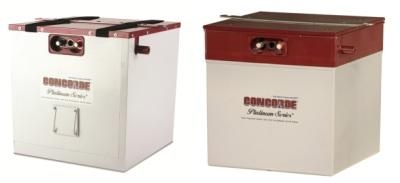STC Approved For Bombardier 600 Series Aircraft As Well
Concorde Battery Corporation’s F-16 Pre-Block 40 and Block 40/50 aircraft batteries have been approved for the Qualified Product Listing. Concorde’s D8565/19-1 pre-block 40 and D8565/20-1 Block 40/50 aircraft batteries are drop in replacements for existing lead acid batteries in the wheel-well installation.

The D8565/19-1 (NSN 6140-01-458-4863) is a heated battery rated at 15Ah and D8565/20-1 (NSN 6140-01-492-0227) is a non-heated battery rated at 17Ah. Both are valve regulated sealed lead acid (VRLA) batteries. Air Forces around the world have depended on the reliability of Concorde’s VRLA technology for over 30 years. Concorde batteries were installed on the F-117 when it was unveiled to the public and continue to be installed on multiple military aircraft including the CH-53, F/A-18, C-130, S-3 Viking, CH-47, C-5, KC-135, F-4, F-5, T-38 and B-1B.
Concorde’s performance can be attributed to unique design features such as proprietary PolyGuard separators (an additional layer of protection against shorting, exclusive to Concorde) robust plate construction, over the cell wall intercell connections for reduced internal resistance and a commitment to quality standards.
Concorde’s VRLA batteries are maintenance free, do not require deep cycling to remove the “memory effects”, do not require water or electrolyte replenishment and have no risk of thermal runaway. Additional benefits of Concorde batteries are that they do not require unique charging equipment, can be serviced in any battery shop, including nickel-cadmium shops, and they ship Hazmat Exempt making transportation less costly, regardless of whether shipping by land, sea or air.
The FAA has granted approval of STC ST01646WI for the Bombardier CL-600-2B16, CL-600-2B19, CL-600-2C10, & CL-600-2D24 to convert from nickel-cadmium or existing lead acid to Concorde’s valve regulated sealed lead acid recombinant gas (RG) batteries.

ST01646WI permits the replacement of the main battery alone, the APU battery alone or both batteries. The main battery is replaced with Concorde’s NEW design RG-223 (17Ah) battery and the APU battery is replaced with the popular RG-380E/44L (42Ah) battery. Both batteries have passed rigorous TSO C-173 testing for duty cycle, electrical performance, temperature extremes, shock/vibration and environmental requirements and are FAA-TSO authorized.
CL-600 Series aircraft are equipped with a variety of dedicated chargers for each battery. Concorde batteries require the Securaplane Model BC-1306 (P/N 100-1084-01) charger. BC-1306 is FAA-PMA approved and is included in the Illustrated Parts Catalog (IPC) of each aircraft model covered by this STC. Installation of the BC-1306 battery charger is not included in this STC since they are already covered by the aircraft IPC. With the BC-1306 installed, RG-380E/44L and RG-223 are drop in replacements for the original equipment nickel-cadmium batteries and no modification to the aircraft is required other than replacing temp sensors with those included in the STC kit. Concorde’s valve regulated lead acid (VRLA) recombinant gas (RG) absorbed glass mat (AGM) technology has been proven as reliable, durable and safe for over 30 years.
The advantages of converting from nickel-cadmium to Concorde include lower cost of acquisition, zero maintenance and reduced battery costs per flight hour. Concorde batteries do not require deep cycling to remove the “memory effects” seen in nickel-cadmium batteries, do not require water or electrolyte replenishment and have no risk of thermal runaway. With the benefit of RG Series batteries shipping Hazmat Exempt, transportation is less costly regardless of whether shipping by land, sea or air.
 ANN's Daily Aero-Term (04.24.24): Runway Lead-in Light System
ANN's Daily Aero-Term (04.24.24): Runway Lead-in Light System ANN's Daily Aero-Linx (04.24.24)
ANN's Daily Aero-Linx (04.24.24) Aero-FAQ: Dave Juwel's Aviation Marketing Stories -- ITBOA BNITBOB
Aero-FAQ: Dave Juwel's Aviation Marketing Stories -- ITBOA BNITBOB Classic Aero-TV: Best Seat in The House -- 'Inside' The AeroShell Aerobatic Team
Classic Aero-TV: Best Seat in The House -- 'Inside' The AeroShell Aerobatic Team Airborne Affordable Flyers 04.18.24: CarbonCub UL, Fisher, Affordable Flyer Expo
Airborne Affordable Flyers 04.18.24: CarbonCub UL, Fisher, Affordable Flyer Expo




